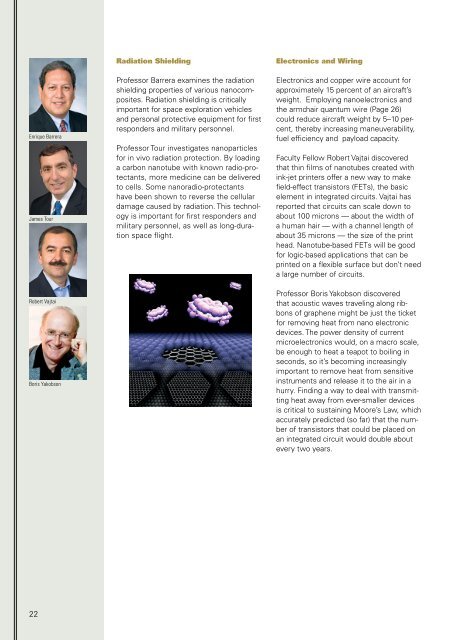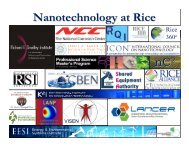Richard E. Smalley Institute for Nanoscale Science and - Center for ...
Richard E. Smalley Institute for Nanoscale Science and - Center for ...
Richard E. Smalley Institute for Nanoscale Science and - Center for ...
You also want an ePaper? Increase the reach of your titles
YUMPU automatically turns print PDFs into web optimized ePapers that Google loves.
Enrique Barrera<br />
James Tour<br />
Robert Vajtai<br />
Boris Yakobson<br />
22<br />
Radiation Shielding<br />
Professor Barrera examines the radiation<br />
shielding properties of various nanocomposites.<br />
Radiation shielding is critically<br />
important <strong>for</strong> space exploration vehicles<br />
<strong>and</strong> personal protective equipment <strong>for</strong> first<br />
responders <strong>and</strong> military personnel.<br />
Professor Tour investigates nanoparticles<br />
<strong>for</strong> in vivo radiation protection. By loading<br />
a carbon nanotube with known radio-protectants,<br />
more medicine can be delivered<br />
to cells. Some nanoradio-protectants<br />
have been shown to reverse the cellular<br />
damage caused by radiation. This technology<br />
is important <strong>for</strong> first responders <strong>and</strong><br />
military personnel, as well as long-duration<br />
space flight.<br />
Electronics <strong>and</strong> Wiring<br />
Electronics <strong>and</strong> copper wire account <strong>for</strong><br />
approximately 15 percent of an aircraft’s<br />
weight. Employing nanoelectronics <strong>and</strong><br />
the armchair quantum wire (Page 26)<br />
could reduce aircraft weight by 5–10 percent,<br />
thereby increasing maneuverability,<br />
fuel efficiency <strong>and</strong> payload capacity.<br />
Faculty Fellow Robert Vajtai discovered<br />
that thin films of nanotubes created with<br />
ink-jet printers offer a new way to make<br />
field-effect transistors (FETs), the basic<br />
element in integrated circuits. Vajtai has<br />
reported that circuits can scale down to<br />
about 100 microns — about the width of<br />
a human hair — with a channel length of<br />
about 35 microns — the size of the print<br />
head. Nanotube-based FETs will be good<br />
<strong>for</strong> logic-based applications that can be<br />
printed on a flexible surface but don’t need<br />
a large number of circuits.<br />
Professor Boris Yakobson discovered<br />
that acoustic waves traveling along ribbons<br />
of graphene might be just the ticket<br />
<strong>for</strong> removing heat from nano electronic<br />
devices. The power density of current<br />
microelectronics would, on a macro scale,<br />
be enough to heat a teapot to boiling in<br />
seconds, so it’s becoming increasingly<br />
important to remove heat from sensitive<br />
instruments <strong>and</strong> release it to the air in a<br />
hurry. Finding a way to deal with transmitting<br />
heat away from ever-smaller devices<br />
is critical to sustaining Moore’s Law, which<br />
accurately predicted (so far) that the number<br />
of transistors that could be placed on<br />
an integrated circuit would double about<br />
every two years.






